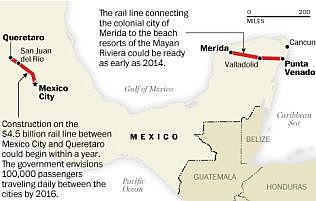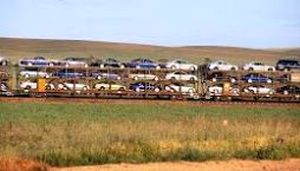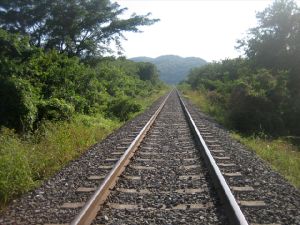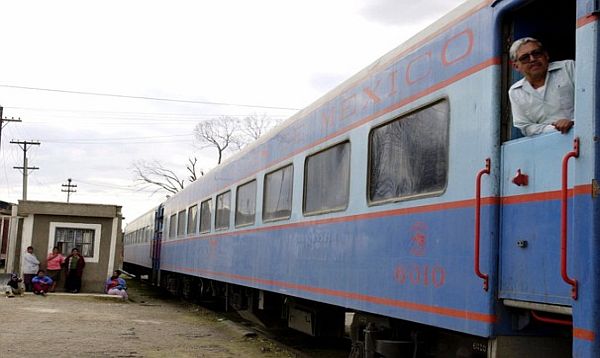Puebla, Mexico — Mexico’s 19th-century leaders spent lavishly to bring the railroad to their young republic, eager to show the world that they were building a modern, technologically advanced nation.
More than 100 years and a few upheavals later, with Mexico’s economy barreling forward but its pride in need of a boost, new President Enrique Peña Nieto has outlined a grand vision to showcase the country’s renewed prosperity and engineering might.
He’ll make the trains run again.
Peña Nieto surprised many at his December 1st inauguration when he announced a multibillion-dollar plan to restore passenger rail service in Mexico, nearly 15 years after his own Institutional Revolutionary Party (PRI) finished dismantling it.
His proposals start with the completion of a rail line across the Yucatan Peninsula linking the colonial city of Merida to the beach resorts of the Mayan Riviera. As soon as next year, cruise ship passengers and sunburned college kids may be swilling cold beers in air-conditioned cars while the scenery zips by at 110 mph, stopping at archaeological sites and jungle lodges.
Far more ambitious will be a $4.5 billion high-speed line between Mexico City and Queretaro, the booming manufacturing and aerospace hub 120 miles northwest of the capital. Long-term plans would extend the route to Mexico’s second-largest city, Guadalajara, eventually filling sleek rail cars with business executives, tourists and families freed up from the country’s clogged highways.
"In the history of Mexico, passenger trains have been a symbol of modernity," Peña Nieto declared during an inaugural speech that laid out his top 10 presidential priorities. "We will once again have passenger service to connect our cities."
 |
The 46-year-old Peña Nieto made his political reputation as governor of the state of Mexico by drafting to-do lists of major hard-hat projects and then checking them off, casting himself as a deeds-not-words leader who stuck to his electoral promises. Much of the infrastructure funding was raised by luring private capital, and officials say they want the trains eventually to be run by private concessions, not a state agency.
But his plans to revive Mexico’s railroad glory have been big on boldness and short on details. In an interview, Mexico’s secretary of transportation and communications, Gerardo Ruiz Esparza, acknowledged that engineers were still drawing up feasibility studies and cost estimates for the Mexico City-Queretaro project, which envisions 100,000 passengers daily riding the rails between the cities by 2016 and construction underway within a year.
"Our productivity depends on this," Ruiz Esparza said. "The rest of the world has its eye on Mexico. This is critical to our competitiveness."
He and other Mexican officials describe the project as an environmentally minded solution to the country’s growing traffic and pollution woes, and a way to ensure that foreign investment in Mexican industry keeps chugging along.
Tracks Clogged With Cargo
Mexico’s existing railroad network was essentially completed more than a century ago, and today the system is a backbone of the $1 billion-a-day trade partnership between the United States and Mexico. Rail lines link deep-water ports on Mexico’s Atlantic and Pacific coasts to assembly plants in the central and northern highlands, then feed directly into the United States, the world’s most lucrative export market.
But with the exception of a few tourist trains, like the Tequila Express in the state of Jalisco and the Copper Canyon railway through the Sierra Madre, Mexico all but eliminated passenger rail service when it shut down the state-run Ferrocarriles Nacionales de Mexico (National Railways of Mexico) in the 1990s, selling off the right of way to private franchise.
"Our country needs its trains back," said Narciso Nava, a lifelong railroad man. "If the president puts his mind to it, he can do it."
The broader Mexican public seems to back that sentiment, but criticism of Peña Nieto’s plans might pick up later, once the costs become clearer.
For now, the biggest worries come from the big freight operators that are joint ventures with US railroad companies.
The north-south corridors of the country’s existing rail network are jammed with doubled-stacked cargo containers loaded with cars, produce, and steel bound for the United States. The talk of adding passenger trains has spooked the companies that invested heavily to form joint ventures and secure government right-of-way concessions after the rail network was privatized.
 |
The same manufacturing export boom that is driving much of Mexico’s prosperity — and the desire to restore passenger rail service — could be hurt by having to share the tracks, operators say, with the unintended consequence of diverting more freight back onto Mexico’s highways.
"We think passenger trains could be a good idea on certain routes," said Jose Zozaya, the president of Kansas City Southern de Mexico, one of Mexico’s two largest freight operators and a subsidiary of US-based Kansas City Southern. "But only if it’s not to the detriment of existing freight traffic."
Many heavily traveled rail corridors in the United States and elsewhere are used for carrying passengers and freight, moving people during the day and cargo at night. But Zozaya said Mexico’s busy routes are too clogged for that, "day or night."
Ruiz Esparza, the transportation and communications secretary, insisted that the Peña Nieto administration wants to increase — not reduce — the amount of cargo carried on Mexico’s rail network. With average speeds for freight trains at less than 15 mph, he said, it often takes three days to move cargo from central Mexico to the border.
That type of congestion suggests that the government will need to carve out entirely new rail lines for passenger service. The goal would be trains that average 100 to 120 mph — speeds that are slower, but more affordable to achieve, than those of bullet trains operating in Europe, Japan, and China.
"Even the TGV [bullet trains] of Europe have to slow down to 90 miles per hour at highway crossings. So the Mexican solution may be somewhere in between," said Bob Johnston, the passenger rail correspondent for Wisconsin-based Trains magazine. "It depends how much they want to spend."
Peña Nieto’s transportation agenda also calls for a third subway line in the city of Monterrey and expanded commuter rail service in Guadalajara and the Mexico City area.
"An Entirely New Experience"
Major investments in railways would mark a turnaround for a country that allowed its track network to deteriorate throughout most of the 20th century, as Mexico poured money into highway construction instead.
The country had more than 15,000 miles of railway lines by 1910, but it has just 10,000 miles of track in use today, according to Teresa Marquez, director of the National Railroad Museum in Puebla, Mexico.
 |
Built across a sprawling train yard at the site of a station whose construction was ordered by national hero Benito Juarez, the museum today is the repository for century-old rail cars and industry archives, from British engineering blueprints to ledger books detailing the wages of Chinese and Irish migrant laborers.
"It took a lot to build those railways," Marquez said. "They have tremendous historical significance."
European engineers began laying tracks across Mexico’s rugged topography in the 1840s, with the first north-south line from Mexico City to the border at El Paso completed in 1884.
The railways became a rolling battlefield during the Mexican Revolution, when insurgent leaders like Francisco "Pancho" Villa used the tracks to move troops and dynamited them if the other side was in pursuit.
The tracks were mostly nationalized after the revolution, and in the decades that followed, the state-run Ferrocarriles Nacionales de Mexico suffered from chronic under-investment and neglect. Mexican rail travel became slow, uncomfortable, and occasionally dangerous - a form of second-class transportation.
The new trains, in contrast, appear to be conceived with the country’s emerging middle class in mind, like the young professionals moving to the suburbs of Queretaro.
"It will be an entirely new experience," said Arturo Grunstein, a railroad historian at Mexico City’s Universidad Autonoma Metropolitana. He’s skeptical that the trains can turn a profit, unless they can lure wealthier Mexicans out of their automobiles.
"The middle and upper classes will need something that really offers an advantage, something that can compete with the comfort of cars and airplanes," he said. "Are they willing to make that shift?"


